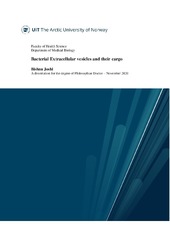Sammendrag
Staphylococcus aureus and Enterococcus faecium are opportunistic pathogens that may cause diseases ranging from minor skin infection to severe blood stream infections. The emergence of methicillin-resistant Staphylococcus aureus (MRSA) and vancomycin-resistant enterococcal strains severely limits treatment options. Bacteria release extracellular vesicles (EVs), defined as “particles naturally released from the cell that are delimited by a lipid bilayer and cannot replicate”. They are packaged with an array of virulence factors, resistant determinants, and nucleic acids and participate in host-microbe and microbe-microbe interactions. EVs might be used for therapeutic applications e.g., carriers for drug delivery, vaccine, and diagnostic biomarkers. The characterization of EV cargo is limited in Gram-positive bacteria. Given the importance of EVs, this thesis aimed to examine proteome and transcriptome of these nanoparticles upon bacterial exposure to various growth conditions. Using a label-free proteomic approach, E. faecium EVs proteome was profiled for the first time. We found that growth phase and growth conditions (e.g., media, sub-MIC dosage of vancomycin) influenced the proteome content. The EVs contained a wide range of different proteins including vaccine candidates, antimicrobial resistance determinants and virulence factors. The sub-inhibitory dosage of vancomycin also influenced the proteome profile of MRSA and revealed relatively increased expression of EV- associated proteins that might be involved in bacterial colonization and antibiotic resistance (e.g., multiple antibiotic resistance regulators, amino acyltransferases, and penicillin binding proteins). Intriguingly, we also demonstrated that EVs attenuated the susceptibility of MRSA to vancomycin, which is commonly used as first-line therapy in clinical practices. Transcriptomic analysis of RNA isolated from S. aureus-derived EVs revealed presence of various RNA biotypes including mRNA, rRNA, tRNA, and small RNA. In summary, the thesis demonstrate that several virulence factors, immunogenic proteins, and/or small RNAs were associated with the EVs isolated from E. faecium and S. aureus.
Har del(er)
Paper I: Wagner, T., Joshi, B., Janice, J., Askarian, F., Škalko-Basnet, N., Hagestad, O.C., … Johannessen, M. (2018). Enterococcus faecium produces membrane vesicles containing virulence factors and antimicrobial resistance related proteins. Journal of Proteomics, 187, 28-38. Also available in Munin at https://hdl.handle.net/10037/14580.
Paper II: Joshi, B., Singh, B., Nadeem, A., Askarian, F., Wai, S.N., Johannessen, M. & Hegstad, K. (2020). Transcriptome profiling of Staphylococcus aureus associated Extracellular Vesicles reveals presence of small RNA-cargo. (Submitted manuscript). Now published in Frontiers in Molecular Biosciences, 7, 566207, available at https://doi.org/10.3389/fmolb.2020.566207.
Paper III: Kumaraswamy, M., Will, K., Joshi, B., Sakoulas, G., Kousha, A., Vaaje-Kolstad, G., … Askarian, F. Bacterial Membrane-Derived Vesicles Attenuate Vancomycin Activity against Methicillin-Resistant Staphylococcus aureus. (Manuscript).


 English
English norsk
norsk
